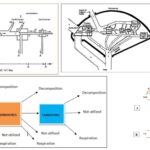In an erythrocyte undergoing glycolysis, what would be the effect of a sudden increase in the concentration of a. ATP? b. AMP? c. fructose-1,6-bisphosphate? d. fructose-2,6-bisphosphate? e. citrate? f. glucose-6-phosphate?
In
an erythrocyte undergoing glycolysis, what would be the effect of a
sudden increase in the concentration of
a. ATP? b. AMP?
c. fructose-1,6-bisphosphate? d. fructose-2,6-bisphosphate?
e. citrate? f. glucose-6-phosphate?
Please login to submit an answer.
a. ATP
ATP acts as an allosteric inhibitor of phosphofructokinase-1 (PFK-1), a key regulatory enzyme in glycolysis.
An increase in ATP concentration signals sufficient energy availability, leading to decreased PFK-1 activity and a subsequent slowdown in glycolytic flux.
This negative feedback mechanism helps maintain energy homeostasis within the cell.
b. AMP
AMP serves as an allosteric activator of PFK-1.
Elevated AMP levels indicate low cellular energy status, prompting an upregulation of glycolysis to generate more ATP.
This positive feedback ensures rapid response to energy demands.
c. Fructose-1,6-bisphosphate (F-1,6-BP)
F-1,6-BP is an intermediate in glycolysis that acts as an allosteric activator of pyruvate kinase (PK), enhancing the conversion of phosphoenolpyruvate to pyruvate.
An increase in F-1,6-BP concentration accelerates the latter stages of glycolysis, promoting efficient energy production.
d. Fructose-2,6-bisphosphate (F-2,6-BP)
F-2,6-BP is a potent allosteric activator of PFK-1 and an inhibitor of fructose-1,6-bisphosphatase.
Elevated levels of F-2,6-BP enhance glycolysis by increasing PFK-1 activity and simultaneously inhibit gluconeogenesis.
This dual regulation ensures a coordinated control of glucose metabolism.
e. Citrate
Citrate functions as an allosteric inhibitor of PFK-1.
An increase in citrate concentration reflects a high level of biosynthetic precursors, signaling to downregulate glycolysis.
This inhibition prevents excessive accumulation of metabolic intermediates.
f. Glucose-6-phosphate (G6P)
G6P acts as an allosteric inhibitor of hexokinase, the enzyme catalyzing the first step of glycolysis.
Elevated G6P levels indicate a bottleneck in downstream glycolytic steps, leading to feedback inhibition of glucose phosphorylation.
This regulation prevents unnecessary consumption of glucose when glycolytic flux is impeded.
- Share on Facebook
- Share on Twitter
- Share on LinkedIn
Helpful: 0%




